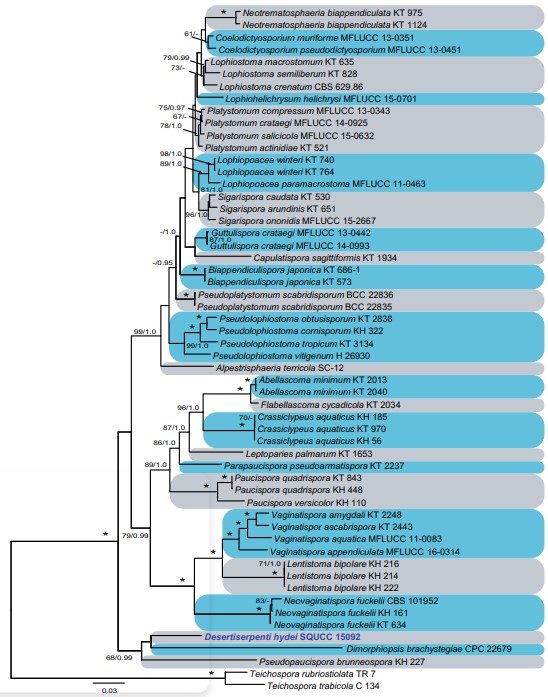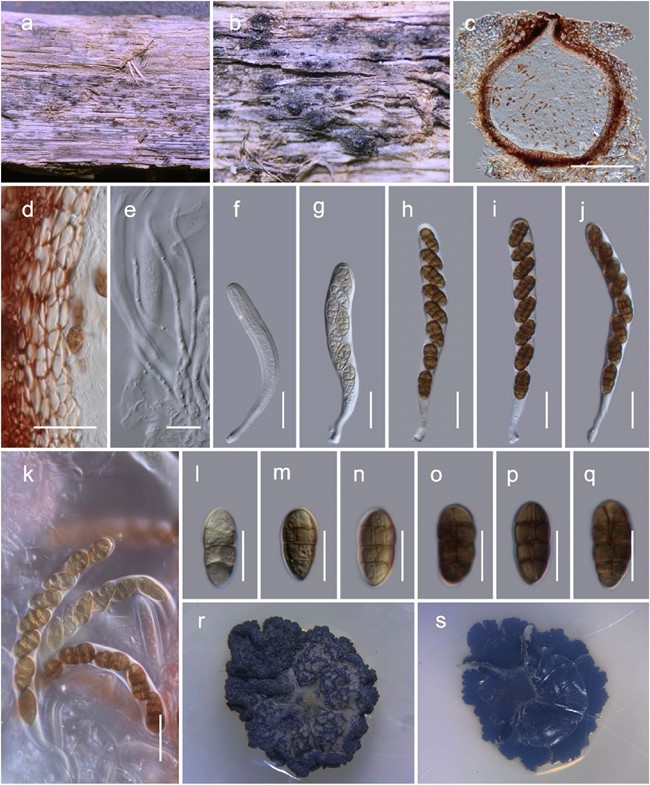Montanitestudina hydei Maharachch., Wanas. & Al‑Sadi, sp. nov.
MycoBank number: MB 837560; Index Fungorum number: IF 837560; Facesoffungi number: FoF 09488; Fig. 18
Etymology: Named in honour of British mycologist K.D. Hyde, for his huge contributions to ascomycete taxonomy.
Saprobic on dead wood of unknown plants. Sexual morph: Ascomata 480–550 µm high, 440–530 µm diam. ( x̄ = 529.4 × 500.1 µm, n = 10), black, immersed, scattered, sometimes gregarious beneath the host periderm or on decorticated wood, partly erumpent, globose, ostiolate. Ostiole central, short, slightly raised, smooth, ostiolar canal filled with hyaline cells. Peridium 35–50 µm wide, comprising 4–5 layers, with outer layer heavily pigmented, thick-walled, comprising dark brown cells of textura angularis, cells towards inside lighter, with inner layer com- posed of pale brown to hyaline, flattened, thin-walled cells of textura angularis. Hamathecium comprising numerous, 1.5–2.5 µm (n = 30) wide, filamentous, branched, septate, guttulate, pseudoparaphyses. Asci 115–130 × 11–15 µm ( x̄ = 120.6 × 12.6 µm, n = 40), 8-spored, bitunicate, fissitunicate, cylindrical, pedicellate, rounded at apex with an ocular chamber. Ascospores 14–18 × 7–10 µm ( x̄ = 16.1 × 7.8 µm, n = 50), overlapping uniseriate, muriform, mostly ellipsoidal, 3 − 4-transversely septate, with 1 − 2 vertical septa, slightly constricted at middle septum, initially hyaline, becoming brown at maturity, upper end rounded, lower end conical, not surrounded by a mucilaginous sheath. Asexual morph: Not observed.
Culture characteristics—Colonies on PDA slow growing reaching 2 cm diam. in four weeks, irregular, superficial to erumpent, blackish-green to black, lacking aerial mycelium, top surface raised centrally and wrinkled, undulate margin, reverse black.
Material examined—OMAN, Al Jabal al-Akhdar (Green Mountain), from dead wood of unknown host, 25.09.2017, SSN Maharachchikumbura (SQU H-123, holotype), ex-type living culture = SQUCC 15173.
GenBank accession numbers: LSU: MW077158; SSU: MW077165; ITS: MW077149; TEF: MW075775.
Notes—Montanitestudina hydei is similar to Muritestudina chiangraiensis Wanas et al. in Testudinaceae due to its globose ascomata with a thin peridium and muri- form ascospores but differs by having biseriate, hyaline ascospores with large guttules whereas M. hydei has uni- seriate, brown ascospores without guttules. Also, these genera are phylogenetically separated in multi-gene phylogenetic analyses (Fig. 8). Montanitestudina hydei and Lepidosphaeria nicotiae Parg.-Leduc are monophyletic in the multigene phylogenetic analyses. However, they are separated by morphological features. Lepidosphaeria nicotiae has globose to subglobose ascomata, clavate asci and 1-septate ascospores with a granulated surface whereas M. hydei has globose ascomata, cylindrical asci and muriform ascospores with a smooth surface.

Fig. 8 Phylogenetic tree inferred using the combined sequences of LSU, SSU, ITS, RPB2 and TEF of the analysed Lophiostomataceae genera. The tree backbone was constructed using maximum likelihood (ML) analysis. The MLB and PP above 60% and 0.95, respectively, are given at the nodes (MLB/PP). An asterisk (*) indicates branches with MLB = 100% and PP values = 1.0. Species are followed by the strain accession numbers. The new strain is indicated in blue bold. The scale bar represents the expected number of changes per site for ML

Fig. 18 Montanitestudina hydei (SQU H-123, holotype). a, b Ascomata on host substrate. c Section of ascoma. d Peridium. e Pseudoparaphyses. f–k Asci. l–q Ascospores. r, s Culture on PDA (note s reverse). Scale bars: c = 200 µm, d, f–k = 20 µm, e, l–q = 10 µm
